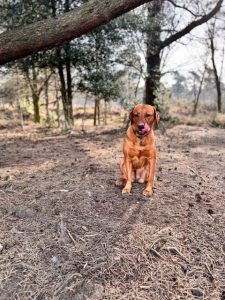
Understanding Ginger’s Food Intolerance: A Journey to Better Health 🐾
Understanding Ginger’s Food Intolerance: A Journey to Better Health 🐾
Meet Ginger, a charming red fox Labrador, bred at Fallowcopse Kennels back in 2023. Now 18 months old, she is thriving – enjoying walks on the South Downs, learning to swim in the sea and continuing to enjoy her Fallowcopse Feeds kibble. As well as the kibble, Ginger eats the dog food brand Butternut Box and always gobbles up treats such as chicken wings.
However, Ginger can sometimes skip meals and certainly defies the typical Labrador stereotype when it comes to food — she can be quite picky, often turning her nose up at meals, much to her owners’ surprise, since Labradors are famously known for their insatiable appetites! Due to this, her owners were interested in seeing if she has any food sensitivities. Food sensitivity testing kits are available via Fallowcopse Feeds and with just a small amount of fur sent off in the post, her owners received a comprehensive guide to which foods Ginger might struggle with.
The results have given us some valuable insights into her health and happiness. For any pet parent, learning about your dog’s intolerances can feel overwhelming at first, but understanding these results is the first step toward creating a diet and lifestyle that helps them thrive.
Let’s break it down!
🐟 Foods Ginger Should Avoid
Ginger’s results showed a high sensitivity to several foods, especially in the fish category. Anchovies, eel, haddock, tuna, and even kelp are top of the list to avoid. Surprisingly, oat flour and redcurrants also came up as problematic, so it’s best to remove these from her daily meals right away.
There’s also a list of “mild” sensitivities, which means they could cause issues if consumed frequently or combined in the same meal. This includes common foods like brown rice, maize flour, noodles, peanuts, honey, and even some healthy options like broccoli, beetroot, and strawberries. While these aren’t as urgent to eliminate, they’re worth keeping an eye on — especially during Ginger’s elimination diet period.
🌳 Environmental Sensitivities: More Than Just Food
Food isn’t the only thing affecting Ginger. Her environment plays a role too. Some surprising triggers popped up here, like ash trees, barley plants, bee pollen, and even the innocent-looking blackberry bush in your garden. Things like perfume, storage mites, and certain indoor plants (like succulents and sword fern) could also be contributing to her discomfort.
Reducing Ginger’s exposure to these environmental irritants can make a noticeable difference, especially when combined with her new dietary plan.
⚙️ Metals: A Hidden Concern
Ginger’s test revealed a high sensitivity to sulphur, with mild sensitivities to selenium and sodium. While metals might not be the first thing you think of, they can sneak into your pet’s life through water, food packaging, or even household products. It’s a good reminder to opt for filtered water and keep an eye on food and treats packaging.
🌞 Vitamin & Mineral Levels: Room for Improvement
Good news: Ginger’s vitamin levels are largely within a healthy range! The only concern is Zinc, which tested a bit low. Zinc plays a role in skin health, immune function, and healing, so it’s worth considering a boost through diet.
On the mineral front, Ginger could use some extra support. Key nutrients like Omega-3 and Omega-6 fatty acids, iron, iodine, magnesium, and copper were found to be lower than ideal. These nutrients are essential for overall well-being, supporting everything from joint health to coat condition and energy levels.
Ginger could transition to Fallowcopse Feeds Optimum Care range. The hydrolysed Salmon is a good source of Zinc and also contains 5 fatty acids high in Omega 3 and 6.
The meat proteins in the optimum care range are hydrolysed meaning that they are naturally engineered to become more readily digestible allowing the body to make full use of their properties.
📝 What’s Next? Action Plan for Ginger
The recommendation is clear: start with a 6–8 week elimination diet focusing first on the high sensitivity foods. This will give Ginger’s gut time to heal and help identify which foods are true culprits.
Once this period is complete and symptoms have subsided, Ginger can begin a gradual reintroduction process. By adding one food back at a time, you can carefully monitor her response and make informed decisions about her diet moving forward.
Don’t forget about her environment! Reducing her exposure to plants, pollens, and household items identified in the report can make a big difference in her comfort level.
💡 Final Thoughts
Ginger’s intolerance results aren’t just a list of dos and don’ts — they’re a roadmap to better health. By making mindful changes, her owners can help Ginger feel her best every day. And remember, this isn’t forever. Many sensitivities can improve over time with care and attention.


